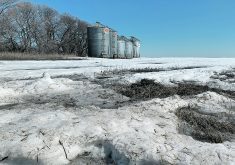Dry weather in North Africa and parts of Europe as well as worries about the potential for delayed spring seeding in the U.S. Midwest will likely start to be issues for market discussion in the coming weeks.
So far in 2019 crop prices have been lackadaisical, weighed down by ample world stocks and the ongoing trade war between the United States and China.
But market discussion will soon start to focus more on production prospects for 2019-20.
We might still be in the deep freeze on the Canadian Prairies, but in milder parts of the Northern Hemisphere, March marks the point when winter crops start to come out of dormancy and farmers prepare for spring planting.
Read Also

Defence investments could benefit agriculture
A bump in Canada’s NATO spending commitments could lead to infrastructure investments that would benefit rural areas
The Feb. 26 Weekly Weather and Crop Bulletin of the U.S. Department of Agriculture notes that it has been exceptionally dry in Spain and the western half of North Africa.
North Africa — Morocco, Algeria and Tunisia — is a major market for durum and if crops there do not do well it can lead to increased durum imports.
Rain accumulation is down by 50 percent or more in parts of Algeria and Morocco over the past 90 days, the USDA bulletin said. But Tunisian crops are good.
“Winter grains were approaching or progressing through the reproductive stages of development and irreversible yield losses are imminent unless rain materializes soon,” the report said of dry Algeria and Morocco.
Mild and dry weather has dominated in Britain and much of France. It was the warmest February on record in much of England. The recent dry weather follows on last summer’s hot dry conditions, and wildfires are becoming an issue. Several were reported on Feb. 27 when the highest ever winter temperature of slightly more than 21 C was reported in London.
France is a major wheat exporter. It and the rest of the European community suffered a major production reduction in 2018 due to dry weather, with wheat dropping to 137.7 million tonnes, down from 151.4 million in 2017.
The mild, dry winter in France had not yet caused significant problems for the 2019 crop. The country’s agricultural office FranceAgriMer said in mid-February that 85 percent of the soft wheat crop was in good to excellent condition, about the same as last year at that point.
Most of France basked in much warmer than normal weather the last week of February with many centres posting record highs for the month. The warm weather brought crops out of dormancy, making them vulnerable if the weather turns cold but generally warmer than normal weather is expected.
The Accuweather.com European spring forecast says the lack of rain in North Africa and Spain will likely continue and the dryness could spread across southern and central Europe. The northern half could see normal to above-normal moisture.
UkrAgroConsult reports that Ukraine’s winter grain crop is coming out of dormancy in good shape after a favourable winter.
Turning to the U.S., there are almost no problems with dryness. There is no part of the U.S. hard red winter wheat belt listed in drought this year.
The USDA survey pegged overall winter wheat seeding at 31.3 million acres, down four percent from last year. Of that, hard red winter area was 22.2 million acres, down three percent.
Regional crop condition reports have not yet begun, but the Kansas state report said its winter wheat crop is mostly fair to good and is better than it was last year at this point.
On Feb. 26, the state listed six percent excellent, 45 percent good, 40 percent fair, seven percent poor and two percent very poor.
Last year at this time it was one percent excellent, 11 percent good, 39 percent fair, 36 percent poor and 13 percent very poor.
In the Midwest, where spring field work normally begins in a few weeks, the winter saw above-normal moisture, on top of excess rain last fall. There is a lot of snow in the northern part of the region and in the southern part many fields are saturated.
Many farmers in the region are concerned about the possibility of delayed seeding. If true, the predicted switch of acres to corn away from soybeans might be difficult because corn is usually seeded first.
Across the equator, Australia has had the hottest summer on record and although a deluge and flooding in northern Queensland caught world headlines, generally the weather was dry.
The country’s Bureau of Meteorology forecasts that March to May will continue to be drier than average in the eastern part of the country, bad news for a part of the country that last year saw severe yield reductions due to dryness. The country produced the smallest wheat crop in 11 years at 17.3 million tonnes.
Western Australia is expected to have normal to slightly above normal moisture in the forecast period. Wheat production in that state last year was good.
All areas of the country are expected to have warmer than normal temperatures through the period. Seeding of winter wheat in Australia happens about the same time as spring wheat seeding in Canada.
Of course, weather during the growing season is most critical for yield potential but if conditions are stressful going into the production year, the uncertainty can provide support to crop prices.















